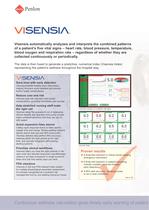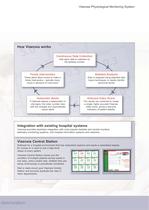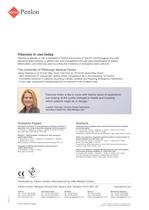
Catalog excerpts

Advanced Monitoring Sixth sense for prediction Visensia Physiological Monitoring System Visensia is the world’s most advanced physiological monitoring system for detecting early clinical patient deterioration u Evidence based early warning system u Analysis and interpretation of the patient’s five vital signs – heart rate, blood pressure, temperature, blood oxygen, and respiratory rate u Rapid prediction of clinical instability reduces fatalities and complications u Helps prioritise clinical workflows and allocation of resources u Award winning patient safety innovation Partnership for Life
Open the catalog to page 1
Visensia automatically analyses and interprets the combined patterns of a patient’s five vital signs – heart rate, blood pressure, temperature, blood oxygen and respiration rate – regardless of whether they are collected continuously or periodically. The data is then fused to generate a predictive, numerical index (Visensia Index) representing the patient’s wellness throughout the hospital stay. Save lives with early detection Visensia enables reliable early intervention, helping clinicians avoid fatalities and prevent further health complications. Reduce cost and risk Visensia aids risk...
Open the catalog to page 2
Visensia Physiological Monitoring System How Visensia works Continuous Data Collection Vital signs data is collected via the bedside monitor Timely Intervention Detailed Analysis These alerts allow nurses to make a timely intervention - typically many hours in advance of crisis point Data is analysed using patented data fusion techniques, to rapidly identify abnormal trends Automatic Alerts Visensia Index Score If Visensia detects a deterioration in vital signs, the index number rises with the changes and automatically issues alerts The results are combined to create a single, highly...
Open the catalog to page 3
Visensia in use today Visensia is already in use in hospitals in Oxford and London in the UK, and throughout the USA, delivering improvements in patient care and management through early identification of patient deterioration, and reducing costs by cutting the incidence of emergency team call-outs. The University of Pittsburgh Medical Centre Using Visensia in its 24 bed Step Down Unit over an 18 month period they found: • Zero incidences of unexpected cardiac arrest compared to 50 in the preceding 18 months. • A threefold reduction in patients becoming critically unstable and requiring...
Open the catalog to page 4All Penlon catalogs and technical brochures
-
Penlon Laryngoscope Range
8 Pages
-
AnaVue 4000
6 Pages
-
Sigma EVA
2 Pages
-
Prima 320 Advance
6 Pages
-
Penlon AV-S Ventilator
2 Pages
-
Penlon Sigma Delta Vaporizer
2 Pages
Archived catalogs
-
ESO 2
2 Pages
-
Penlon SP M8 Patient Monitor
4 Pages
-
Penlon SP M5 Patient Monitor
4 Pages
-
Equipment Hire
2 Pages
-
Patient Monitor Range
12 Pages
-
Nuffield 200 Ventilator
2 Pages
-
Technical Training
4 Pages
-
Service Hire
1 Pages
-
Life-Care
1 Pages
-
Penlon MRI Product Range
8 Pages
-
Laryngoscope Range
8 Pages
-
MAK Receiver Jar Range
2 Pages
-
Medical Rail System
4 Pages
-
V7
8 Pages
-
SP M5 Patient Monitor
4 Pages
-
SP M8 Patient Monitor
4 Pages
-
AV-S Ventilator
2 Pages
-
Prima 460 Anaesthesia System
4 Pages
-
Oriel? 3000 Patient Monitor
4 Pages
-
AV900 Ventilator
2 Pages
-
SP Electric Suction Range
2 Pages
-
Laryngoscope Sets
12 Pages
-
Oriel 4000
4 Pages
-
Medical Rail
4 Pages
-
SP Elecrtic Suction Range
2 Pages
-
MAK Receiver Jars
2 Pages
-
AV500 Injector Suction Unit
2 Pages
-
Medical Gas Regulators
2 Pages
-
SC760 Suction Controller
2 Pages
-
Laryngoscope Range
12 Pages
-
A100SP Absorber
2 Pages
-
A200SP Absorber
2 Pages
-
AV800/80 Ventilator
2 Pages
-
Sigma Delta Vaporizer
2 Pages
-
Prima SP and Prima SP2
12 Pages




















































